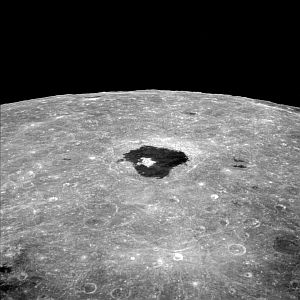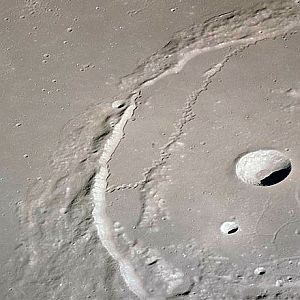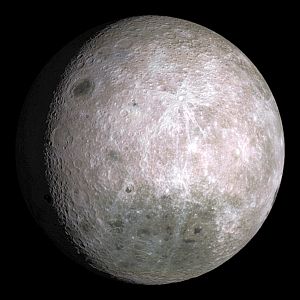
Für eine deutsche Übersetzung dieser Seite einfach die Brandenburger Flagge anklicken
 |
Click the Brandenburg Flag for a German translation Für eine deutsche Übersetzung dieser Seite einfach die Brandenburger Flagge anklicken |


|
|
MoonA collection of pictures of our Moon,
|
|


 |
The Apollo Moon Program not only delivered the first Moon rocks to Earth, it also provided a huge number of high resolution pictures of hand-selected areas. To the left is a picture of Mount Marilyn, the first Lunar feature named by an astronaut. Apollo 8 pilot Jim Lovell named the mountain after his wife. Topographically, the mountain at the eastern rim of the Sea of Tranquility stand out so significantly that it was used as a major reference point for the landing approach of Apollo 11. In 2017, the International Astronomical Union officially recognized
the name.
|


|
Jim Lovell piloting the Apollo 8 command module, December 1968 Source: Planetary Society  
|
Far side during Apollo 8's first orbit December 24, 1968 Source: NASA  
|
Near-full-Moon view December, 1968 Source: Lunar & Planetary Institute  
|

|
The first crewed Lunar mission started on December 21, 1968 with the launch of Apollo 8. On December
24, Apollo 8 started the first of ten orbits around the moon. Among the pictures taken during the flight were high resolution images of the far side (above). On Christmas Eve, 1968, the crew took the famous Earthrise picture of Earth above the Lunar surface (right). Apollo 8 also took pictures of potential landing sites for future missions. The site in the picture below center was called "Approved Candidate Landing Site 1." |

|

  Tsiolkovsky Crater on the far side December 24, 1968 Source: Planetary Society |
  Picture of a potential landing site December 1968 Source: Lunar & Planetary Institute |
  Crater Giordano Bruno on the near side December 1968 Source: Lunar & Planetary Institute |


|
On May 18, 1969, Apollo 10 was launched. The spacecraft remained in Lunar orbit for three days and 31 orbits, doing "everything but landing on the Moon." Pictures included photographs of the Lunar module and of the command module above the Moon's surface. |
  Apollo 10 Command Module, seen from the detached Lunar Module; May 21, 1969 Source: Smithsonian Institute |
  Apollo 10 Lunar Module seen through the porthole of the Command Module; May 22, 1969 Source: Wikipedia |


| The following Apollo missions were of course mainly about landing on the Moon, and exploring the lunar surface, but all flights also resulted in a number of really good shots from orbit. |
  Crater Daedalus on the Lunar farside Apollo 11, July 1969 Source: NASA |
  Crater Herschel Apollo 12, November 1969 Source: NASA |

  Apollo 15 in Lunar orbit, showing the scientific instrument module; July, 1971 Source: Lunar & Planetary Institute |
  Crater Posidonius Apollo 15, July, 1971 Source: Wikiwand |
  Crater Van de Graaff on the far side Apollo 17, December 1972 Source: Lunar & Planetary Institute |


Automatic probes after the Apollo Program |

|
XXXXXXXXXXXXLuna 19 and Luna 22
Towards the end of its Luna Programme, the Soviet Union placed
|

|
|
Panoramic image taken by Luna 22 in 1974 Source: Don P. Mitchell |
Panoramic image taken by Luna 19 in 1971 Source: Don P. Mitchell |

|
Luna 19 was launched on September 28, 1971, entered Lunar orbit on October 2 and was active until
November 1, 1972. Luna 22 was launched on May 29, 1974, entered Lunar orbit on June 22 and delivered images and data for 16 months until November 1975.
While both probes took a lot of images of the Lunar surface there were only a few pictures published. XXXXXXXXXXXXXXXXXXXXXXXXXXXXXXXXXXXXXXXXXXXXXXLuna 22; Source: Wikipedia |

|


|
XXXXXXXXXXXXXXXXXXXXXXClementine On January 25, 1994, Clementine, a joint venture between NASA and several US military institutions was launched. The probe entered Lunar orbit approximately one month after launch and spent two month mapping the Lunar surface. Clementine delivered the best pictures of the Moon's polar regions to date. Contact to the probe was lost in June 1994.
|
 |

  Lunar North Pole Source: NASA / JPL |
  Moon with Venus in the distance Source: Wikipedia |
  Lunar South Pole Source: NASA / JPL |


|
XXXXXXXXXXXXXLunar Reconnaissance Orbiter Most of the more recent pictures from Lunar orbit were taken by NASA's Lunar Reconnaissance Orbiter. The probe was launched on June 18, 2009. It entered Lunar orbit on June 23, 2009 and has been operative ever since. By September 2015, LROC had imaged nearly three-quarters of the lunar surface at high resolution. As an added bonus, LRO also delivered pictures of all Apollo landing sites as well as photographs of other American, Russian and Chines automaric probes on the moon.
All pictures taken by LRO are public record. You can find good selections of them at
space.com and at the
Planetary Society. |
 |

  First picture taken by LRO, June 30, 2009 Source: Wikipedia |
  Apollo 11 landing site Source: Planetary Society |
  Unnamed Crater in Sinus Iridum, September 8, 2009 Source: Planetary Society |

 |

|
|
Central peak in crater Tycho, June 10, 2011 Source: Wikipedia |
Center of crater Antoniadi, May 14, 2012 Source: Planetary Society |


|
Kaguya-Selene Source: JAXA / Planetary Society  
|
Chang'E 2 Source: China.org  
|
Beresheet Source: nocamels.com  
|

  Composit image of the far side from pictures and data from Clementine and Kaguya. Source: Planetary Society |
  Crater Laplace A Chang'E 2; October 28, 2010 Source: Planetary Society |
  Beresheet's final image before crash-landing on the Moon on April 4, 2019. Source: Planetary Society |


|
The latest pictures from lunar orbit came from Japan's Kaguya spacecraft and from China's
Chang'E 2 probe. SELENE, better known by its nickname Kaguya was launched on September 14 2007 and stayed in orbit from October 3, 2007 until June 10, 2009. Chang'E 2 was launched on October 1, 2010 and entered orbit on October 6, 2010. The probe left lunar orbit on June 8, 2011 was pirst placed at the Earth–Sun L2 Lagrangian point and later conducted a flyby of asteroid Toutatis. On February 22, 2019, Beresheet, Israel's first lunar probe was launched with an American Falcon rocket. The probe did not succed in the attempted soft landing on the Moon, but in good old "Ranger" fashion, it delivered pictures from the surface until it crashed into the Sea of Serenity on April 11, 2019.
|


|
|
Click here to see earlier moon pictures | Click here to move on to the Lunar surface |
|

|
Back to Solar System Page |
Back to Space Page |
Back to English Main Page |
 Back to Start Page |